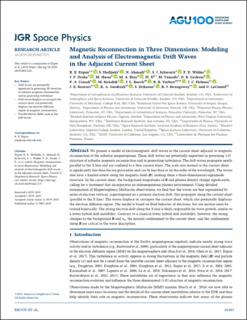Magnetic Reconnection in Three Dimensions: Modeling and Analysis of Electromagnetic Drift Waves in the Adjacent Current Sheet
Ergun, Robert E; Hoilijoki, Sanni; Ahmadi, N.; Schwartz, S.J.; Wilder, F.D.; Drake, James F.; Hesse, Michael; Shay, Michael A.; Ji, H.; Yamada, M; Graham, Daniel B.; Cassak, P.A.; Swisdak, M; Burch, J. L.; Torbert, R.B.; Holmes, JC; Stawarz, JE; Goodrich, Katherine A; Eriksson, S.; Strangeway, Robert J.; LeContel, O
Journal article, Peer reviewed
Published version

Åpne
Permanent lenke
https://hdl.handle.net/11250/2732273Utgivelsesdato
2019Metadata
Vis full innførselSamlinger
- Department of Physics and Technology [2161]
- Registrations from Cristin [10402]
Originalversjon
Journal of Geophysical Research: Space Physics. 2019, 124 (12), 10085-10103. 10.1029/2019JA027275Sammendrag
We present a model of electromagnetic drift waves in the current sheet adjacent to magnetic reconnection at the subsolar magnetopause. These drift waves are potentially important in governing 3‐D structure of subsolar magnetic reconnection and in generating turbulence. The drift waves propagate nearly parallel to the X line and are confined to a thin current sheet. The scale size normal to the current sheet is significantly less than the ion gyroradius and can be less than or on the order of the wavelength. The waves also have a limited extent along the magnetic field (B), making them a three‐dimensional eigenmode structure. In the current sheet, the background magnitudes of B and plasma density change significantly, calling for a treatment that incorporates an inhomogeneous plasma environment. Using detailed examination of Magnetospheric Multiscale observations, we find that the waves are best represented by series of electron vortices, superimposed on a primary electron drift, that propagate along the current sheet (parallel to the X line). The waves displace or corrugate the current sheet, which also potentially displaces the electron diffusion region. The model is based on fluid behavior of electrons, but ion motion must be treated kinetically. The strong electron drift along the X line is likely responsible for wave growth, similar to a lower hybrid drift instability. Contrary to a classical lower hybrid drift instability, however, the strong changes in the background B and no, the normal confinement to the current sheet, and the confinement along B are critical to the wave description.